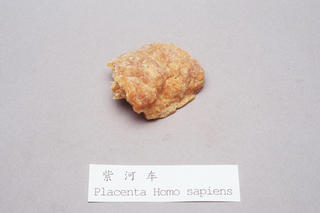Human Placenta
Contents
Nomenclature
Other Names:
Historical Use of Human Placenta
Human Placenta in Traditional Chinese Medicine
Background
Taipanfen Ì¥ÅÌ·Û
Chinese Name (pinyin): Ziheche
Chinese Name :
Common Name :Human Placenta
Specific Name : Placenta hominis
Scientific Name:
Collection : The drug is removed from amnion and umbilkical cord, wash repeatedly until free from blood, steamed or boiled in water for a moment and dried.
Description : Rounded or dish shaped ellipsoidal, 9 - 15cm in diameter, varying in thickness, yellow or yellowish brown, one side uneven with irregular stripes, the other side relatively smooth, often with remnant of the umbilical cord, surrounded with fine blood vessels. Texture hard and fragile, odour stinking.
Identification :
Processing : Eliminate dust, break to pieces or grind to fine powder.
Action : To warm the kidney, to replenish vital essence, qi and blood.
Indication : emaciation, hectic fever, night sweating, cough, shortness of breath and anorexia in consumptive diseases; impotence, seminal emission; infertility; lack of lactation
Precautions :
Dosage : 2 to 3 g, to be ground into powder for oral administration.
Storage : Preserve in a dry place, protected from moth.
Synonymns for Human Placenta
Patent Medicines and Medicines with Multiple Ingredients that include Human Placenta
Pharmaceutical Information
Chemical Constituents
Evidence or the Use of Human Placenta in the Treatment of Epilepesy
Basic Science
Animal Studies
Cohort, Case-Control and Non-Randomized Trials
Randomized Controlled Trials
Meta-Analysis
1st Five Results: pubmed search
Subeen Hong, Byung Soo Kang, Oyoung Kim, Sangeun Won, Hyeon Soo Kim, Jeong Ha Wie, Jae Eun Shin, Sae Kyung Choi, Yun Sung Jo, Yeon Hee Kim, Mihi Yang, Huiwon Kang, Dong-Wook Lee, In Yang Park, Joong Shin Park, Hyun Sun Ko
The associations between maternal and fetal exposure to endocrine-disrupting chemicals and asymmetric fetal growth restriction: a prospective cohort study.
Front Public Health: 2024, 12;1351786
[PubMed:38665245]
[WorldCat.org]
[DOI]
(I e)
Janay M Vacharasin, Joseph A Ward, Mikayla M McCord, Kaitlin Cox, Jaime Imitola, Sofia B Lizarraga
Neuroimmune mechanisms in autism etiology - untangling a complex problem using human cellular models.
Oxf Open Neurosci: 2024, 3;kvae003
[PubMed:38665176]
[WorldCat.org]
[DOI]
(I e)
Maricarmen Abrego-Navarro, Rodrigo Villalobos, Jaime Sanchez, Deisa Lamela, Cindy Fu, Erika Guerrero, Paulino Vigil-De Gracia, Sandra López-Vergès, Mairim A Solis
Placental inflammation in a fetal demise of a SARS-CoV-2-asymptomatic, COVID-19-unvaccinated pregnant woman: a case-report.
BMC Pregnancy Childbirth: 2024, 24(1);319
[PubMed:38664805]
[WorldCat.org]
[DOI]
(I e)
Jaiberth Antonio Cardona-Arias, Jaime Carmona-Fonseca
Prospective study of malaria in pregnancy, placental and congenital malaria in Northwest Colombia.
Malar J: 2024, 23(1);116
[PubMed:38664687]
[WorldCat.org]
[DOI]
(I e)
Ramon Portillo, Cilia Abad, Tetiana Synova, Petr Kastner, Heblik Daniel, Radim Kucera, Rona Karahoda, Frantisek Staud
Cannabidiol disrupts tryptophan metabolism in the human term placenta.
Toxicology: 2024;153813
[PubMed:38663822]
[WorldCat.org]
[DOI]
(I a)
